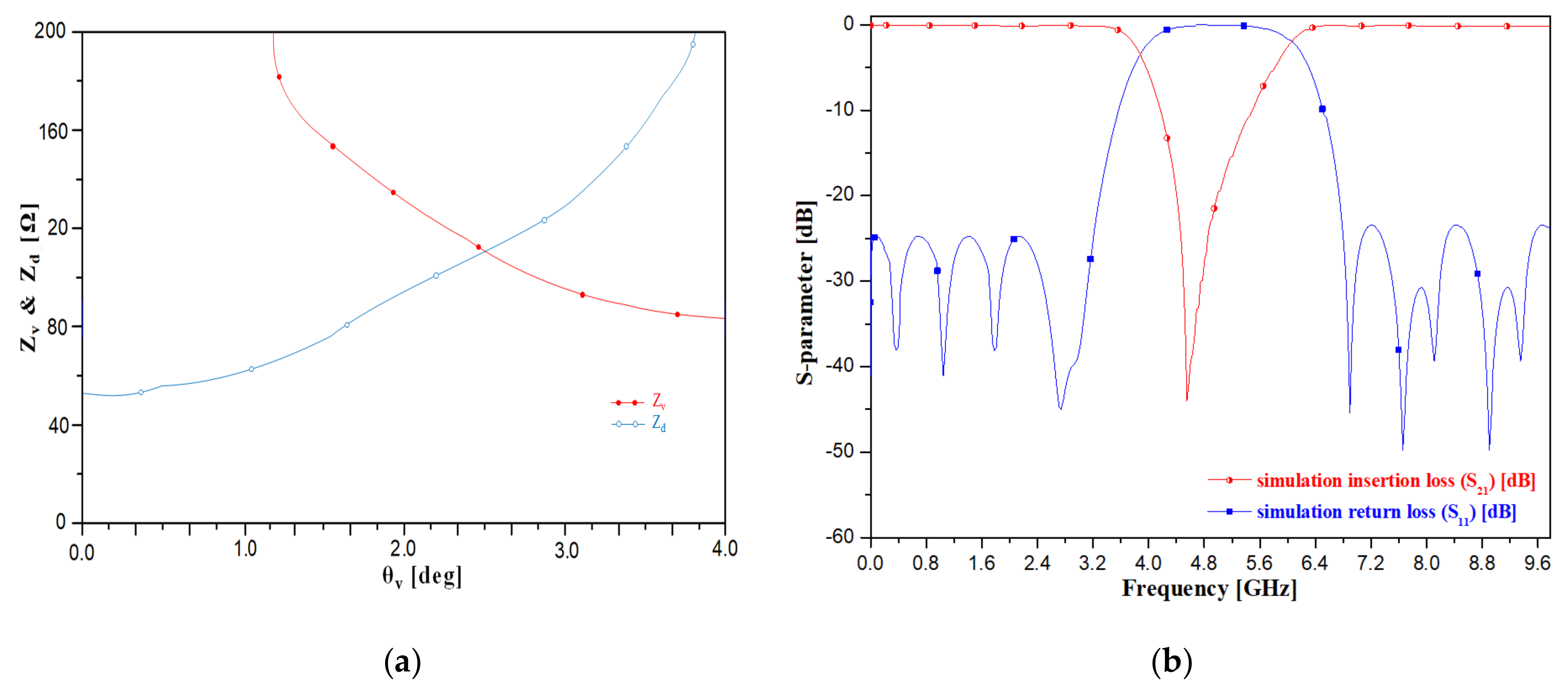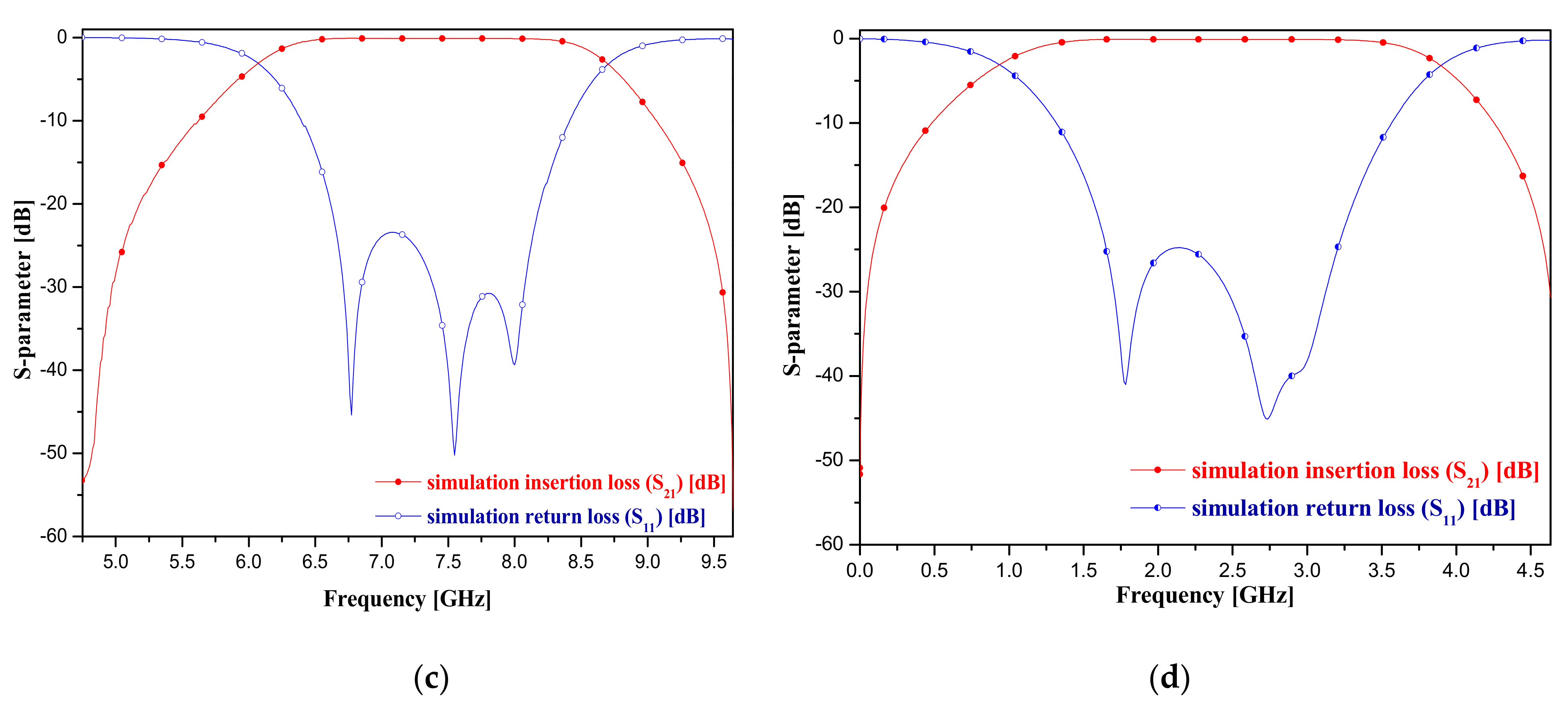Design of Dual Ultra–Wideband Band–Pass Filter Using Stepped Impedance Resonator λg/4 Short Stubs and T–Shaped Band-Stop Filter
Abstract
:1. Introduction
2. Working Principle of Dual-Band BPF
3. Realization Process
3.1. Design and Fabrication
3.2. Experimental Results
4. Discussion
5. Conclusions
Author Contributions
Funding
Informed Consent Statement
Data Availability Statement
Acknowledgments
Conflicts of Interest
References
- Zhang, J.; Liu, Q.; Zhang, D.-W.; Qu, Y. High Selectivity Single Wideband and Quad-Band HTS Filters Using Novel Quad-Mode Resonators with Self-Coupled Structure. IEEE Access 2021, 9, 103194–103203. [Google Scholar] [CrossRef]
- Rahman, M.; Park, J.-D. A Compact Tri-Band Bandpass Filter using Two Stub-Loaded Dual Mode Resonators. Prog. Electromagn. Res. M 2018, 64, 201–209. [Google Scholar] [CrossRef] [Green Version]
- Hsu, C.-Y.; Chen, C.-Y.; Chuang, H.-R. Microstrip Dual-Band Bandpass Filter Design with Closely Specified Passbands. IEEE Trans. Microw. Theory Tech. 2012, 61, 98–106. [Google Scholar] [CrossRef]
- Zhang, Z.C.; Chu, Q.X.; Chen, F.C. Compact dual-band bandpass filters using open-/short-circuited stub-loaded λ/4 resonators. IEEE Microw. Wirel. Compon. Lett. 2015, 25, 657–659. [Google Scholar] [CrossRef]
- Zhu, H.; Abbosh, A. Single- and Dual-Band Bandpass Filters Using Coupled Stepped-Impedance Resonators with Embedded Coupled-Lines. IEEE Microw. Wirel. Components Lett. 2016, 26, 675–677. [Google Scholar] [CrossRef]
- Liu, X.; Wu, W.; Ji, P.; Yuan, N. Design of Compact Dual-Passband Filters by Parasitic Passband with Controllable Passbands. IEEE Microw. Wirel. Components Lett. 2018, 28, 410–412. [Google Scholar] [CrossRef]
- Ren, B.; Ma, Z.; Liu, H.; Guan, X.; Wen, P.; Wang, X.; Masataka, O. Miniature dual-band bandpass filter using modified quarter-wavelength SIRs with controllable passbands. Electron. Lett. 2019, 55, 38–40. [Google Scholar] [CrossRef]
- Sami, A.; Rahman, M. A very Compact Quintuple Band Bandpass Filter Using Multimode Stub Loaded Resonator. Prog. Electromagn. Res. C 2019, 93, 211–222. [Google Scholar] [CrossRef] [Green Version]
- Wei, F.; Yu, J.H.; Zhang, C.Y.; Zeng, C.; Shi, X.W. Compact Balanced Dual-Band BPFs Based on Short and Open Stub Loaded Resonators with Wide Common-Mode Suppression. IEEE Trans. Circuits Syst. II Express Briefs 2020, 67, 3043–3047. [Google Scholar] [CrossRef]
- Chen, W.-Y.; Weng, M.-H.; Chang, S.-J. A New Tri-Band Bandpass Filter Based on Stub-Loaded Step-Impedance Resonator. IEEE Microw. Wirel. Compon. Lett. 2012, 22, 179–181. [Google Scholar] [CrossRef]
- Chen, W.-Y.; Su, Y.-H.; Kuan, H.; Chang, S.-J. Simple method to design a tri-band bandpass filter using asymmetric SIRs for GSM, WIMAX, and WLAN applications. Microw. Opt. Technol. Lett. 2011, 53, 1573–1576. [Google Scholar] [CrossRef]
- Li, J.; Chen, J.; Wang, J.; Shao, W.; Xue, Q.; Xue, L. Miniaturised microstrip bandpass filter using stepped impedance ring resonators. Electron. Lett. 2004, 40, 1420–1421. [Google Scholar] [CrossRef]
- Li, J. Multi-mode resonators with quad-/penta-/sext-mode resonant characteristics and their applications to bandpass filters. Int. J. RF Microw. Comput. Aided Eng. 2017, 27, e21072. [Google Scholar] [CrossRef]
- Sun, S.-J.; Su, T.; Deng, K.; Wu, B.; Liang, C.-H. Compact Microstrip Dual-Band Bandpass Filter Using a Novel Stub-Loaded Quad-Mode Resonator. IEEE Microw. Wirel. Compon. Lett. 2013, 23, 465–467. [Google Scholar] [CrossRef]
- Hejazi, Z.M. A fast design approach of compact microstrip multiband bandpass filters. Microw. Opt. Technol. Lett. 2012, 54, 1075–1079. [Google Scholar] [CrossRef]
- Wang, X.; Wang, J.; Zhu, L.; Choi, W.-W.; Wu, W. Compact Stripline Dual-Band Bandpass Filters with Controllable Frequency Ratio and High Selectivity Based on Self-Coupled Resonator. IEEE Trans. Microw. Theory Tech. 2019, 68, 102–110. [Google Scholar] [CrossRef]
- Xie, Y.; Chen, F.-C.; Li, Z. Design of Dual-Band Bandpass Filter With High Isolation and Wide Stopband. IEEE Access 2017, 5, 25602–25608. [Google Scholar] [CrossRef]
- Weng, M.-H.; Zheng, F.-Z.; Lai, H.-Z.; Liu, S.-K. Compact Ultra-Wideband Bandpass Filters Achieved by Using a Stub-Loaded Stepped Impedance Resonator. Electron 2020, 9, 209. [Google Scholar] [CrossRef] [Green Version]
- Karimi, G.; Salehi, A.; Javidan, F. Miniaturized (UWB) band pass filter using elliptical-ring multi-mode stub-loaded resonator (MM-SLR). Radioengineering 2018, 27, 732–737. [Google Scholar] [CrossRef]
- Gan, D.; He, S.; Dai, Z.; Wang, J. A quad-band bandpass filter using split-ring based on T-shaped stub-loaded step-impedance resonators. Microw. Opt. Technol. Lett. 2017, 59, 2098–2104. [Google Scholar] [CrossRef]
- Hsieh, L.-H.; Chang, K. Compact lowpass filter using stepped impedance hairpin resonator. Electron. Lett. 2001, 37, 899. [Google Scholar] [CrossRef]
- Ma, K.-X.; Ma, J.-G.; Do, M.; Yeo, K. Compact two-order bandpass filter with three finite zero points. Electron. Lett. 2005, 41, 846. [Google Scholar] [CrossRef]
- Zhu, L.; Devabhaktuni, V.; Wang, C.; Yu, M. A bandpass filter with adjustable bandwidth and predictable transmission zeros. Int. J. RF Microw. Comput. Eng. 2009, 20, 148–157. [Google Scholar] [CrossRef]
- Zakharov, A.; Rozenko, S.; Pinchuk, L.; Litvintsev, S. Microstrip Quazi-Elliptic Bandpass Filter with Two Pairs of Antiparallel Mixed-Coupled SIRs. IEEE Microw. Wirel. Components Lett. 2021, 31, 433–436. [Google Scholar] [CrossRef]
- Weng, M.-H.; Huang, C.-Y.; Dai, S.-W.; Yang, R.-Y. An Improved Stopband Dual-Band Filter Using Quad-Mode Stub-Loaded Resonators. Electron 2021, 10, 142. [Google Scholar] [CrossRef]
- Ren, B.; Liu, H.; Ma, Z.; Ohira, M.; Wen, P.; Wang, X.; Guan, X. Compact Dual-Band Differential Bandpass Filter Using Quadruple-Mode Stepped-Impedance Square Ring Loaded Resonators. IEEE Access 2018, 6, 21850–21858. [Google Scholar] [CrossRef]
- Zhou, L.H.; Chen, J.X. Differential dual-band bandpass filters with flexible frequency ratio using asymmetrical shunt branches for wideband CM suppression. IEEE Trans. Microw. Theory Techn. 2017, 65, 4606–4615. [Google Scholar] [CrossRef]
- Tang, J.; Liu, H.; Yang, Y. Compact Wide-Stopband Dual-Band Balanced Filter Using an Electromagnetically Coupled SIR Pair With Controllable Transmission Zeros and Bandwidths. IEEE Trans. Circuits Syst. II Express Briefs 2020, 67, 2357–2361. [Google Scholar] [CrossRef]
- Firmansyah, T.; Praptodiyono, S.; Wiryadinata, R.; Suhendar, S.; Wardoyo, S.; Alimuddin, A.; Chairunissa, C.; Alaydrus, M.; Wibisono, G. Dual-wideband band pass filter using folded cross-stub stepped impedance resonator. Microw. Opt. Technol. Lett. 2017, 59, 2929–2934. [Google Scholar] [CrossRef]
- Hong, J.-S.G.; Lancaster, M.J. Microstrip filters for RF/Microwave Applications; John Wiley & Sons: Hoboken, NJ, USA, 2004; Volume 167. [Google Scholar]





| Parameter | Value [Ω] | Parameter | Value [Degree] |
|---|---|---|---|
| Zs1 | 89.2 | θs1 | 2.31 |
| Zs2 | 136 | θs2 | 7.07 |
| ZT1 | 75.0 | θT1 | 2.82 |
| ZT2 | 134 | θT2 | 2.34 |
| Zsm | 142 | θsm | 2.79 |
| Zv | 86.6 | θv | 30 |
| Zd | 75 | θd | 45 |
| Ref [#] | f0 [GHz] | IL [dB] | RL [dB] | Δ [%] | Size [λg] | ||||||||
|---|---|---|---|---|---|---|---|---|---|---|---|---|---|
| f01 | f02 | f03 | f01 | f02 | f03 | f01 | f02 | f03 | f01 | f02 | f03 | ||
| this work | 2.43 | 7.49 | - | 0.102 | 0.102 | - | 19.13 | 19.96 | - | 120 | 105 | - | 0.0708 × 0.0533 |
| [2] | 1.57 | 2.40 | 3.45 | 0.41 | 1.39 | 1.97 | 27.7 | 12.3 | 16.2 | 20.0 | 7.40 | 5.50 | 0.54 × 0.44 |
| [4] | 2.4 | 5.80 | - | 1.35 | 1.97 | - | 17.0 | 15.0 | - | 4.63 | 3.60 | - | 0.39 × 0.25 |
| [6] | 2.45 | 3.42 | - | 1.02 | 3.01 | - | - | - | - | 3.70 | 1.50 | - | 0.17 × 0.18 |
| [7] | 2.36 | 5.83 | - | 1.10 | 1.60 | - | - | - | - | 5.80 | 3.10 | - | 0.16 × 0.18 |
| [10] | 1.57 | 2.40 | 3.50 | 16.0 | 1.50 | 2.30 | 9.00 | 18.9 | 13.5 | N/A | N/A | - | 0.72 × 0.82 |
| [11] | 1.80 | 3.50 | 5.20 | 1.20 | 1.80 | 2.00 | 5.00 | 24.0 | 14.0 | N/A | N/A | - | 1.89 × 0.03 |
| [13] | 2.09 | 3.52 | 5.45 | 1.18 | 0.54 | 0.88 | 15.1 | 16.8 | 29.5 | 11.3 | 20.0 | 12.1 | 0.12 × 0.42 |
| [20] | 1.34 | 2.20 | 3.32 | 1.32 | 1.26 | 2.23 | 16.3 | 24.6 | 17.3 | 5.22 | 3.63 | 4.21 | 0.32 × 0.23 |
| [26] | 2.60 | 5.80 | - | 1.10 | 2.10 | - | 15.0 | 15.0 | - | 10.4 | 3.60 | - | 0.26 × 0.34 |
| [27] | 3.58 | 5.60 | - | 1.10 | 1.80 | - | 17.0 | 17.0 | - | 5.80 | 3.40 | - | 0.25 × 0.47 |
| [28] | 1.75 | 3.64 | - | 2.00 | 1.10 | - | N/A | N/A | - | 2.00 | 5.00 | - | 0.14 × 0.27 |
Publisher’s Note: MDPI stays neutral with regard to jurisdictional claims in published maps and institutional affiliations. |
© 2021 by the authors. Licensee MDPI, Basel, Switzerland. This article is an open access article distributed under the terms and conditions of the Creative Commons Attribution (CC BY) license (https://creativecommons.org/licenses/by/4.0/).
Share and Cite
Yoon, K.; Kim, K. Design of Dual Ultra–Wideband Band–Pass Filter Using Stepped Impedance Resonator λg/4 Short Stubs and T–Shaped Band-Stop Filter. Electronics 2021, 10, 1951. https://doi.org/10.3390/electronics10161951
Yoon K, Kim K. Design of Dual Ultra–Wideband Band–Pass Filter Using Stepped Impedance Resonator λg/4 Short Stubs and T–Shaped Band-Stop Filter. Electronics. 2021; 10(16):1951. https://doi.org/10.3390/electronics10161951
Chicago/Turabian StyleYoon, Kicheol, and Kwanggi Kim. 2021. "Design of Dual Ultra–Wideband Band–Pass Filter Using Stepped Impedance Resonator λg/4 Short Stubs and T–Shaped Band-Stop Filter" Electronics 10, no. 16: 1951. https://doi.org/10.3390/electronics10161951
APA StyleYoon, K., & Kim, K. (2021). Design of Dual Ultra–Wideband Band–Pass Filter Using Stepped Impedance Resonator λg/4 Short Stubs and T–Shaped Band-Stop Filter. Electronics, 10(16), 1951. https://doi.org/10.3390/electronics10161951







